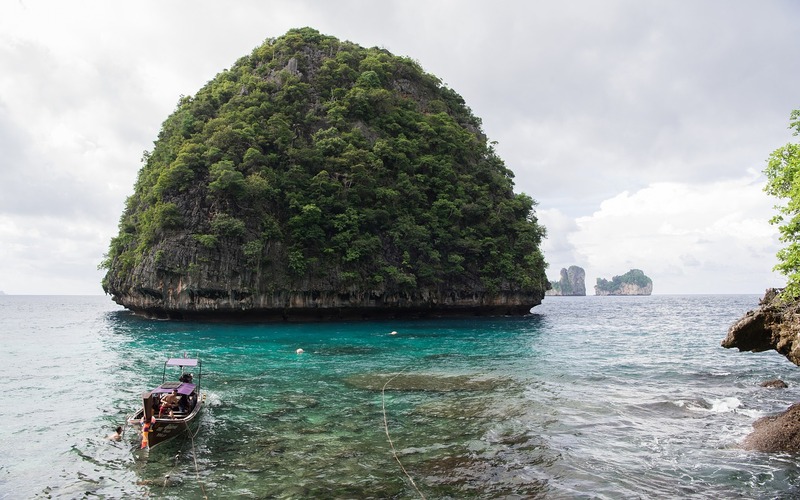The month of August gives a hot and humid weather to most parts of Thailand. You can expect to see a lot of rainfall during afternoons for northern regions. However, weather will be drier for Southwest coast during this month. As a result, most Europeans prefer to visit here. It increases the cost you have to bear when exploring Thailand during August. Let’s learn more on how it would be like to visit Thailand during August.
The Weather in Thailand in August
Across Thailand, August is a hot, humid, and rainy month. The average temperature remains constant from July, around 27-32°C (80-90°F), with Bangkok and other central areas seeing highs of 33°C (91°F). Humidity stays oppressively high, above 75% on average, which can make the heat feel even warmer. The rains continue nationwide, though they begin tapering off in the south. The showers typically come in heavy afternoon downpours rather than continuous storms.
The weather varies somewhat by region in August. The north sees its wettest month, particularly the Chiang Mai area, as the southwest monsoon focuses its moisture here. Daily rain and storms are likely. Meanwhile, the Andaman Coast has its second-driest month as the southwest monsoon shifts away. Phuket gets only occasional storms and Koh Samui stays mostly dry. Ko Chang and the east coast see continued rains and rough seas from the ongoing southwest monsoon. The Gulf Coast around Ko Samui stays sheltered.
Regional Weather in Thailand
Here’s what to expect from the weather in different regions of Thailand in August:
- Bangkok and Central Thailand: Very hot with high humidity. Afternoon thunderstorms and downpours are frequent, and skies stay cloudy, but rain tapers off from July.
- Northern Thailand: The peak of the rainy season. Chiang Mai and Chiang Rai see frequent rain with storms and flooding possible. Roughly 60-190 mm (2.5-7.5”) of rain falls over 15-16 days on average.
- Northeastern Thailand: Hot and humid with moderate rain, around 160-220 mm (6-8.5”) over 14-16 rainy days in Nakhon Ratchasima and Udom Thani.
- Eastern Seaboard: Continued rainy season weather. Rough seas from the southwest monsoon with possible heavy rain and storms inland around 200 mm (8”) in Pattaya.
- Southern Gulf Coast: Ko Samui stays relatively dry while the mainland around Surat Thani sees increased rain, around 190 mm (7.5”) over 14 days in August. Humid and hot.
- Andaman Coast: Koh Chang and Ranong are still quite rainy from the monsoon, but Phuket and Krabi shift into their driest period with just occasional quick storms. Skies start to clear later in August.
Best Places to Visit in Thailand in August
With the rainy season in full swing, August requires some careful destination planning in Thailand. Here are some of the best places to visit:
- Phuket and the Southern Islands: Phuket experiences its second driest month in August, making it a good choice if you’re set on the beaches. On average, 130 mm (5”) of rain falls over just 11 rainy days. The skies clear towards the end of the month. Koh Samui, Koh Tao, and Koh Phi Phi also stay relatively dry.
- Bangkok: The capital sees fewer rainy days versus June and July. Bangkok offers plenty of indoor activities, including Museums, Shopping Malls, Art Galleries, Cooking Classes, Cabaret Shows, and Art Museums. The afternoon rains provide cooling relief from the heat and humidity as well.
- Chiang Mai: Expect frequent rain in the north’s main city, but attractions like temple visits and cooking classes can work around the showers. The lush countryside is beautiful and jungle treks continue.
- Ko Chang: Thailand’s second largest island after Phuket continues to see heavy rainfall on its mix of beaches and jungles. But it offers discounted hotel rates in August. Activities focus on waterfalls, hiking, and relaxation.
Best Activities and Experiences in Thailand in August
⛗ Explore the lush side of Thailand
August is smack dab in the middle of the rainy season, which means lush green mountains, gushing waterfalls, and fewer tourists. Northern Thailand, particularly around Chiang Mai and Pai, feels more like the air is alive with misty woods and rice fields in their brightest.
⛗ Chase waterfalls at their peak
It’s the time when waterfalls are actually raging. The best are Erawan Falls, Thi Lo Su, and Khun Korn when the monsoons arrive. Access is sometimes limited due to heavy rain, so just double-check locally before you go.
⛗ Island hopping on the Gulf side
The Andaman coast is way too wet for comfort. Stay within the Gulf of Thailand Coast, where the climate remains pretty regular throughout the year. The islands of Koh Samui, Koh Phangan, and Koh Tao offer the opportunity to dive in clear waters and take a swim or enjoy beach life with a lot more good weather patterns than on the West Coast.
⛗ Check out indoor markets and malls
Bangkok’s mega-malls like Siam Paragon, IconSiam, and Terminal 21 are more than just shopping. There’s food, art, exhibitions, and even aquariums. Great way to kill a stormy day without feeling like you’re wasting time.
⛗ Take a jungle trek with a local guide
The jungles are green and wild in August. Multi-day hikes near Chiang Mai or Mae Hong Son show you a different side of the country. Go with local guides who understand the terrain and shifting weather patterns.
⛗ Get a traditional Thai massage during a downpour
You’ll find massage shops everywhere. Getting a proper Thai massage while the rain hits the roof is an experience in itself. It’s affordable, relaxing, and a great way to recover after long travel days.
Crowds and Costs in August
August is considered high season in Thailand, with European vacationers joining Asian visitors. Hotel rates and crowds remain elevated, particularly at the popular beach resorts. Mid-August sees Thais travel for Mother’s Day. The weather keeps some visitors away, though, so you can often negotiate discounted hotel rates at beach areas. Overall costs remain raised across dining, activities, and transport.
Here are some tips for crowds and costs:
- Head to lesser-visited spots like Koh Kood for a quieter beach vacation over crowded Phuket. Or enjoy the cultural sites in Chiang Mai versus package-tour heavy Bangkok.
- Book accommodations well in advance for popular destinations and look for promotions since occupancy is lower.
- Expect impacted activities like guided tours and water sports to be more expensive. Shop around as prices can vary.
- Hire a private car or guide rather than joining crowded group excursions. The personalized experience is often worth the extra expense.
What to Wear in Thailand on a August Trip
The hot, humid weather continues nationwide in August. With average highs of 32-34°C (90-93°F), light and loose-fitting clothing is essential. Breathable natural fabrics will keep you coolest. Pack your rain jacket and umbrella, as the afternoon downpours can be sudden and heavy. The cooler mountain areas allow adding a light sweater or jacket at night. Here are some clothing tips:
- Light dresses, skirts, shorts, tanks, and short sleeve shirts and blouses will be most comfortable. Slip-on sandals or flip-flops work best.
- Synthetic fabrics like polyester get clammy. Cotton and linen are good choices, or performance fabrics that wick moisture like Dri-FIT.
- Bring a poncho or light raincoat for sightseeing. Consider water-resistant shoes or sandals.
- In the mountains around Chiang Mai, add long pants and a light sweater or hoodie for cooler mornings and nights.
- Dress conservatively when visiting temples. Cover shoulders and knees.
- Don’t forget sunglasses and hats for sun protection, plus swimwear if you’ll hit the beach.
Thailand continues its wettest weather across the north in August, while the south and islands start to dry out. Flexibility for dealing with rain showers will be essential, but you can still find pleasant beaches, cultural sites, and outdoor adventures if you choose the right regions. With the high season ongoing, costs remain elevated, but hotel deals can provide some value as occupancy declines.
Recommended Places to Stay During Your August Trip
⩨ Bangkok – Sukhumvit or Silom
Central location, great food, and nightlife options await you in Sukhumvit. Silom is a little bit quieter, near Lumpini Park, and also closer for when you just want to temple-hop easily. It will prevent you from getting stuck in traffic and bad weather (as long as you stay near the Skytrain stations)!
⩨ Chiang Mai – Old City or Riverside
A short walk away is the Old City, filled with temples, cafes, and night markets. However, the Riverside area is less frantic, with elegant boutique hotels and mist that will billow in when it rains. You can also go for Trekking and Cooking classes.
⩨ Koh Samui – Chaweng or Bophut
Chaweng is a bit more lively if you are into nightlife and beach parties. On the calm side, Bophut is centered around Fisherman’s Village, which is a collection of low-key restaurants and good walking spaces.
⩨ Koh Tao – Sairee Beach or Ao Leuk
Sairee is quieter, with better opportunities for snorkeling and just relaxing. You get the ideal blend of action and chill vibes.
⩨ Pai – Town Center or Hillside
Food, markets, and bars are just a short walk from the centre of town. Enjoy being in a hillside bungalow where you can relax and hear the rain. Rocky, mud-filled roads can get really sticky. It is better to be safe than to be far from such a road on a motorbike.
Essential Packing Checklist for August Travel in Thailand
- Rain is common, so get quick-dry shirts and shorts!
- Raincoat (and possibly water-resistant poncho) – small and durable
- Mosquito repellent – wet season brings more bugs
- Sunscreen – UV is still strong, especially near water
- Passport – with 6 months validity
- Printed/digital copies of documents – backup in case of issues
- Cash in small bills – useful for rural areas or transport
- Waterproof phone pouch – saves your gear during downpours
- Power bank – long travel days or power cuts happen
Must-Try Thai Dishes in August
- Tom Kha Gai (Coconut Chicken Soup)
An aromatic chicken soup made with coconut milk and flavoured with galangal and lemongrass.
- Gaeng Daeng (Red Curry)
It is a tasty red curry made with coconut milk, bamboo shoots, and protein of your choice. It is served over a bowl of steamed rice on cold rainy nights.
- Som Tam (Papaya Salad)
Fresh, spicy, and crunchy dish that is available everywhere.
- Pad See Ew
Wide rice noodles stir-fried with egg and Chinese broccoli in soy sauce.
- Grilled Pork Skewers (Moo Ping)
A popular street snack. Sweet, savory, and smoky. Often eaten with sticky rice.
- Khao Man Gai (Thai Chicken Rice)
Simple, mild, and satisfying. Poached chicken over rice cooked in broth, served with a flavorful dipping sauce. A go-to meal on travel days.
Simple, mild, and satisfying. Steamed served with poached chicken and gravy. It is a go-to meal on travel days.
- Thai Herbal Teas
Butterfly pea flower tea, lemongrass tea are delicious non-caffeinated beverages that help to cool the body down and benefit your digestion. Common in cafes.
- Tropical Fruits
Peak season fruits are Rambutans, mangosteens, and langsat. In August, it’s everywhere on the markets. Cheap, fresh, and super hydrating.
- Roti with Banana and Condensed Milk
This is a hot, crunchy, street-fried goodness. A feel-good smoothie, perfect for when you’re hiding from the rain and need something that is pretty much like a warm hug in a glass.
An Expert’s Guide to Visiting Thailand in August – FAQs
1. How disruptive is the rain in August for travel plans?
Thailand has a tropical monsoon climate, which means that the rain is pretty extensive and short-lived, with sometimes only late afternoon or evening rain. The majority of flights and ferries are operating on time, but some smaller boat journeys are cancelled.
2. Are there any regions that should be completely avoided in August?
Avoid the Andaman coast if you are okay with gray beaches and no tours. The hardest hit areas will be Phuket, Krabi, and Koh Phi Phi. Trails can be unsafe. Rather, stick to the Gulf islands and stay just as much in the interior with areas like Chiang Mai and Pai.
3. Can I still go diving or snorkeling in August?
Yes, but location matters. One side of the Andaman is both inaccessible and risky. It’s worth making a call to a dive shop in town before you go, as an occasional storm can affect the visibility.
4. Do local festivals or events still happen during the rainy season?
Some festivals carry on no matter what the weather. However, the local night markets will still be in operation, and so will their cultural shows unless it is pouring.
5. How does the rain affect transportation within cities?
When heavy rain sets in, Bangkok and Chiang Mai streets get flooded. Use BTS/MRT whenever you are in Bangkok. Carry a poncho, walk through no more than ankle-deep water, and allow additional time between connections.
6. Is jungle trekking safe during the rainy season?
Well, it can be, if you pick the right venue and hosts. Trails in or near Chiang Mai, Mae Hong Son, and Pai are possible with local guides who know the terrain. Avoid steep or unmaintained paths. Wear trekking shoes, and anticipate wet ground.
8. Can I still enjoy the beaches in August?
Only on the Gulf side. August is also good for the beach in Koh Samui, Koh Phangan, and Koh Tao. Always check local tide charts and do not swim in rough conditions. Keep to busy beaches with lifeguards; don’t go to empty beaches in stormy conditions.
9. What are the benefits of visiting Thailand in August?
Visiting Thailand in August means fewer tourists, lower costs, and lush, vibrant landscapes after the monsoon rains.
10. How should I plan day trips or tours in unpredictable weather?
Go for the morning tours because it mostly rains in the late afternoons. Go for booking shorter tours or day trips that have indoor segments. Based on this, you may want to think twice about a full-day excursion unless you have clear skies. Please ensure that you agree with the cancellation or refund policies before making a deposit or payment.













